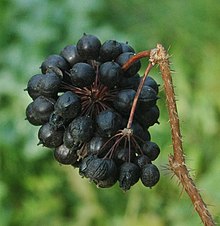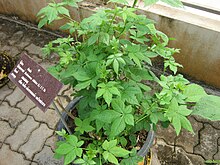Eleutherococcus
| Eleutherococcus | ||||||||||||
|---|---|---|---|---|---|---|---|---|---|---|---|---|

Eleutherococcus henryi , umbellate inflorescences and fruits |
||||||||||||
| Systematics | ||||||||||||
|
||||||||||||
| Scientific name | ||||||||||||
| Eleutherococcus | ||||||||||||
| Maxim. |
Eleutherococcus is a genus of plants within the Araliaceae family. The almost 40 species are common in eastern Asia . Some types are used in traditional Chinese medicine.
description

Vegetative characteristics
They are mostly deciduous shrubs or small trees . They are mostly reinforced. The long-stalked leaves are divided in the shape of a hand . Stipules are present.
Generative characteristics
In annual total inflorescences are doldy partial inflorescences . The relatively small, mostly hermaphrodite flowers are radial symmetry and five-fold. There is only one circle with five stamens . Two to five carpels have become an ovary grown. The two to five styles are free to fused.
The ripe fruits are usually blue to black.
ecology
The pollination is done by insects.
Systematics and distribution
The genus Eleutherococcus was established in 1859 by Karl Johann Maximowicz in Primitiae Florae Amurensis , page 132, published in Mémoires Presentes a l'Académie Impériale des Sciences de St.-Pétersbourg par Divers Savans et lus dans ses Assemblées , Volume 9. Synonyms for Eleutherococcus are Acanthopanax (Decne. & Planch.) Miq. and Plectronia Lour.
The Eleutherococcus species are distributed in eastern Asia from the Himalaya region via China , south-eastern Siberia , Korea , Japan and Taiwan to the Philippines . The center of biodiversity is central and western China with around 18 species.




There are almost 40 species in the genus Eleutherococcus :
- Eleutherococcus baoxinensis (XPFang & CKHsieh) PSHsu & SLPan : This endemic only thrives on shady slopes in dense forests at altitudes of about 2200 meters only in Baoxing in the Chinese province of Sichuan .
- Eleutherococcus brachypus (Harms) Nakai (Syn .: Eleutherococcus obovatus (G.Hoo) H.Ohashi ): It thrives at altitudes of 1000 to 2000 meters in the Chinese provinces of Gansu , Ningxia and Shaanxi .
- Eleutherococcus cissifolius (Griff. Ex CBClarke) Nakai (Syn .: Acanthopanax cissifolius (Griff. Ex Seem.) Harms , Aralia cissifolia Griff. Ex Seem. ): It iswidespreadfrom Bhutan , Sikkim , Nepal to Tibet and Yunnan .
- Eleutherococcus divaricatus (Siebold & Zucc.) SYHu (Syn .: Acanthopanax divaricatus (Siebold & Zucc.) Seem. , Kalopanax divaricatus (Siebold & Zucc.) Miq. , Panax divaricatus Siebold & Zucc. , Eleutherococcus rufinervis (Nakai) SYHu ): It occurs only on the Japanese islands of Hokkaidō , Honshu , Kyushu and Shikoku .
- Eleutherococcus eleutheristylus (G.Hoo) H.Ohashi : It thrives on mountain slopes in the Chinese provinces of Gansu and Shaanxi (only in Hua Shan).
- Eleutherococcus giraldii (Harms) Nakai (Syn .: Eleutherococcus humillimus (YSLian & XueL.Chen) YFDeng , Eleutherococcus yui (HLLi) SYHu ): It grows on mountain slopes at elevations from 1,300 to 3,500 meters in the Chinese provinces of Gansu, Henan , Hubei , Ningxia , Qinghai , Sichuan, Shaanxi and Yunnan.
-
Eleutherococcus henryi olive. There are two varieties:
- Eleutherococcus henryi olive. var. henryi (Syn .: Acanthopanax henryi (Oliv.) Harms ): It thrives at altitudes of 800 to 3200 meters in the Chinese provinces of Anhui, Henan, Hubei, Jiangxi, Shaanxi, Shanxi, Sichuan and Zhejiang.
- Eleutherococcus henryi var. Faberi (Harms) SYHu (Syn .: Eleutherococcus connatistylus (SCLi & XMLiu) CHKim & BYSun , Eleutherococcus huangshanensis C.H.Kim & BYSun ): It thrives at altitudes of 1200 to 1700 meters in the Chinese provinces of southern Huang Anhui Shan), southern Shaanxi (only Zhongnan Shan) and northwestern Zhejiang (only Tianmu Shan).
- Eleutherococcus higoensis (Hatus.) H.Ohba : This endemic occurs only on the Japanese island of Kyushu.
- Eleutherococcus hypoleucus (Makino) Nakai : This endemic occurs only on the Japanese island of Honshu.
- Eleutherococcus japonicus (. Franch & Sav.) Nakai (Syn .: Acanthopanax japonicus Franch & Sav.. , Eleutherococcus spinosus var. Japonicus . (Franch & Sav) H.Ohba. ): You only come to the Japanese islands of Honshu, Kyushu and Shikoku before.
- Eleutherococcus lasiogyne (Harms) SYHu (Syn .: Eleutherococcus wardii (WWSm.) SYHu ): It thrives at altitudes of 2000 to 3400 meters in southeastern Tibet and in the Chinese provinces of Sichuan and northwestern Yunnan. It is used as a medicinal plant.
-
Eleutherococcus leucorrhizus olive. (Syn .: Acanthopanax leucorrhizus (Oliv.) Harms ): It is used as a medicinal plant. There are four varieties:
- Eleutherococcus leucorrhizus var. Fulvescens (Harms & Rehder) Nakai : It thrives at altitudes of 1000 to 3100 meters in the Chinese provinces of northern Guangdong, Guizhou, western Henan, Hubei, Hunan, Jiangxi, Sichuan and Yunnan.
- Eleutherococcus leucorrhizus olive. var. leucorrhizus (Syn .: Eleutherococcus leucorrhizus var. brevipedunculatus Y.R.Ling , Eleutherococcus leucorrhizus var. axillaritomentosus (C.Ho) H.Ohashi , Eleutherococcus cuspidatus (G.Hoo) H.Ohashi ): It grows at altitudes from 100 to 3,200 meters in the Chinese provinces of Anhui, Gansu, Guangdong, Guizhou, Hubei, Hunan, Jiangxi, Shaanxi, Sichuan, Yunnan and Zhejiang.
- Eleutherococcus leucorrhizus var. Scaberulus (Harms & Rehder) Nakai (Syn .: Eleutherococcus simonii (Simon-Louis ex Mouill.) Hesse ): It thrives at altitudes of 1000 to 3000 meters in the Chinese provinces of Anhui, northern Guangdong, Guizhou, western Henan , Hubei, Hunan, Jiangxi, Sichuan, Yunnan and Zhejiang.
- Eleutherococcus leucorrhizus var. Setchuenensis (Harms) CBShang & JYHuang (Syn .: Eleutherococcus setchuenensis (Harms) Nakai , Eleutherococcus setchuenensis var. Latifoliatus (C.Ho) H.Ohashi ): It thrives in the Chinese provinces of 1000 to 3200 meters Gansu, Guizhou, Henan, Hubei, Shaanxi and Sichuan.
- Eleutherococcus nikaianus (Koidz. Ex Nakai) H.Ohashi : It occurs only on the Japanese islands of Honshu and Kyushu.
- Eleutherococcus nodiflorus (Dunn) SYHu (Syn .: Eleutherococcus gracilistylus var. Nodiflorus (Dunn) H.Ohashi , Eleutherococcus gracilistylus (WWSm.) SYHu , Eleutherococcus villosulus (Harms) SYHu , Eleutherococcus nodiflorus (Dunn) SYHu , Eleutherococcus pubescens (Pamp.) CHKim & BYSun ): It thrives in the eastern distribution area at altitudes of up to 1000 meters and in the western up to 3000 meters. It is common in Taiwan and in the Chinese provinces of southern Anhui, Fujian , Gansu, Guangdong, Guangxi, Guizhou, Henan, Hubei, Hunan, southern Jiangsu , Jiangxi , Shaanxi, Shanxi, Sichuan, Yunnan and Zhejiang . It is used as a medicinal plant.
- Eleutherococcus rehderianus (Harms) Nakai (Syn .: Acanthopanax rehderianus Harms ): It thrives at altitudes of 2000 to 2600 meters in the Chinese provinces of Hubei, Shaanxi and Sichuan.
- Eleutherococcus scandens (G.Hoo) H.Ohashi : It thrives at altitudes below 800 meters in the Chinese provinces of Anhui, northern Fujian, Jiangxi and Zhejiang.
- Bristly taiga root ( Eleutherococcus senticosus (Rupr. & Maxim.) Maxim. , Syn .: Acanthopanax senticosus (Rupr. & Maxim.) Harms , Hedera senticosa Rupr. & Maxim. ): It is common in China, Japan , Korea and Russia . It is used as a medicinal plant.
- Eleutherococcus sessiliflorus (Rupr. & Maxim.) SYHu (Syn .: Acanthopanax sessiliflorus (Rupr. & Maxim.) Seem. , Panax sessiliflorus Rupr. & Maxim. , Eleutherococcus seoulensis (Nakai) SYHu ): It is common in China and Korea. It is used as a medicinal plant.
- Eleutherococcus setosus (HLLi) YRLing : It thrives at altitudes below 1,300 meters in Taiwan and in the Chinese provinces of southern Fujian, Guangdong, Guangxi, Guizhou, Hunan, Jiangxi and Yunnan.
- Eleutherococcus setulosus (Franch.) SYHu (Syn .: Eleutherococcus pseudosetulosus C.H. Kim & BYSun , Eleutherococcus zhejiangensis (XJXue & STFang) H.Ohashi ): It thrives at altitudes below 1300 meters, Taiwan and in the Chinese provinces of southern Fujian, Guangxidong , Guangxidong Guizhou, Hunan, Jiangxi and Yunnan.
- Eleutherococcus Sieboldianus (Makino) Koidz. (Syn .: Acanthopanax Sieboldianus Makino ): It occurs in Japan.
- Eleutherococcus spinosus (L. f.) SYHu (Syn .: Acanthopanax spinosus (L. f.) Miq. , Panax spinosum L. f. ): It occurs only on the Japanese islands of Honshu and Kyushu.
- Eleutherococcus trichodon (Franch. & Sav.) H.Ohashi : This endemic occurs only in the southern to southwestern part of the Japanese island of Honshu .
- Eleutherococcus trifoliatus (L.) SYHu (Syn .: Acanthopanax aculeatus (Aiton) Witte , Acanthopanax trifoliatus (L.) Voss , Zanthoxylum trifoliatum L. ): It iswidespreadin India , Thailand , China, Japan and the Philippines . It is used as a medicinal plant.
- Eleutherococcus verticillatus (G.Hoo) H.Ohashi (Syn .: Eleutherococcus xizangensis (YRLi) H.Ohashi ): It thrives in shady and moist forests at altitudes of 2900 to 3200 meters only in the southeastern part of the autonomous region of Tibet. It is used as a medicinal plant.
-
Eleutherococcus wilsonii (Harms) Nakai : There are two varieties:
- Eleutherococcus wilsonii (Harms) Nakai var. Wilsonii (Syn .: Eleutherococcus nanpingensis (XPFang & CKHsieh) PSHsu & SLPan , Eleutherococcus stenophyllus (Harms) Nakai ): It thrives at altitudes of 2500 to 3600 meters in Tibet and in the Chinese provinces , western Hubei, southern Shaanxi, Sichuan and Yunnan.
- Eleutherococcus wilsonii var. Pilosulus (Rehder) PSHsu & SLPan (Syn .: Eleutherococcus pilosulus (Rehder) CHKim & BYSun , Eleutherococcus giraldii var. Pilosulus (Rehder) SYHu ): It grows at altitudes from 2,400 to 2,900 meters in the Chinese provinces of Gansu and Qinghai .
swell
- Qibai Xiang, Porter P. Lowry: Araliaceae. : Eleutherococcus Maximowicz , p. 466 - the same text online as the printed work , In: Wu Zheng-yi, Peter H. Raven, Deyuan Hong (Ed.): Flora of China. Volume 13: Clusiaceae through Araliaceae , Science Press and Missouri Botanical Garden Press, Beijing and St. Louis, 2007, ISBN 978-1-930723-59-7 . (Sections Description, Distribution and Systematics)
Individual evidence
- ↑ a b c d e f g h i j k l m n o p q r s t u v w x y z aa ab ac ad Qibai Xiang, Porter P. Lowry: Araliaceae. : Eleutherococcus Maximowicz , p. 466 - the same text online as the printed work , In: Wu Zheng-yi, Peter H. Raven, Deyuan Hong (Ed.): Flora of China. Volume 13: Clusiaceae through Araliaceae , Science Press and Missouri Botanical Garden Press, Beijing and St. Louis, 2007, ISBN 978-1-930723-59-7 .
- ^ Eleutherococcus at Tropicos.org. Missouri Botanical Garden, St. Louis, accessed May 19, 2014.
- ↑ a b c d e f g h i Rafaël Govaerts (Ed.): Eleutherococcus. In: World Checklist of Selected Plant Families (WCSP) - The Board of Trustees of the Royal Botanic Gardens, Kew . Retrieved April 29, 2018.
- ↑ a b c d Eleutherococcus in the Germplasm Resources Information Network (GRIN), USDA , ARS , National Genetic Resources Program. National Germplasm Resources Laboratory, Beltsville, Maryland. Retrieved May 19, 2014.
Web links
- Entries about Eleutherococcus in Plants For A Future . Retrieved March 5, 2012.